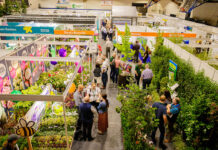The results are in for BSBI’s thirteenth New Year Plant Hunt, when plant-lovers across Britain and Ireland head out to see what is flowering in their local patch. More than 3,000 people – a record number! – took part in the Hunt, after the hottest summer on record was followed by an unusually wet December. Here’s a breakdown of the wild or naturalised plants our intrepid hunters recorded in bloom in their local area over the New Year period1:
- 629 plant species in bloom, a 30% increase compared to last year and the third-highest total in the history of the Hunt.
- Almost twice as many people took part this year: 3,336 people 2 went out hunting, either individually, as part of small family groups or by joining organised group Hunts, compared to 1,691 last year.
- In total, 21,096 records of plants in flower were submitted: more than double last year’s total of 10,199.
- 2,205 lists were submitted, an increase of 120% compared to 1,002 last year.
- As in previous years, the three most frequently recorded species were Daisy, Dandelion and Groundsel.
- Around half the species in bloom were flowering later than expected vs around a quarter flowering earlier than expected.
Julia Hanmer, BSBI’s Chief Executive said “It’s been inspirational to see all the participation and results coming into this year’s New Year Plant Hunt! It was a joy to take part myself and also to hear about other people’s experiences on social media, with so many people joining the hunt for the first time this year. There was a fantastic sense of the botanical community coming together to learn about and contribute to our understanding of wild plants. Thank you to everyone who took part”.
As in previous years, the milder south and the coastal areas of Britain and Ireland had the highest numbers of species in flower3 – 100 species in Swanage, 87 in Caister-on-Sea, 81 in Taunton. As in previous years, urban areas also tended to have more non-native species in flower than rural areas, as there are more sheltered and disturbed places with warm microclimates where alien plants can thrive: the ‘heat-island’ effect.
This year’s Hunt was preceded by an unusually mild but wet December across the UK – the temperature was 2.8 degrees above average, according to UK Met Office data4. This mild weather allowed ‘Autumn Stragglers’ to keep flowering, as they were not knocked back by frost as in last year’s Hunt which followed severe frosts in early December and the coldest winter for a decade.
The main findings5 from this year’s data were:
-
-
- 53% of the flowering species recorded were of plants which normally flower after midsummer and had managed to carry on flowering. These include ‘Autumn Stragglers’ such as Yarrow, Common Ragwort and White Dead-nettle. This proportion is very similar to previous years6.
- 27% were ‘Springtime Specialists’ like Primrose and Lesser Celandine, so there is no indication of an early spring, although we did see more records of Lesser Celandine this year (314 records) than last (56 records).
- 20% of the records submitted were of species we might reasonably expect to flower at New Year, or species which we cannot easily be categorised as either ‘early’ or ‘late’. These include typical ‘All Year Rounders’ such as Shepherd’s-purse as well as ‘Winter Specialists’ such as Winter Heliotrope.
- The top three most frequently seen species, as in previous years, were Daisy, Groundsel and Dandelion, all plants that we would expect to be flowering at this time of year.
- Common Ragwort and Smooth Hawk’s-beard, common plants of urban habitats, and Lesser Celandine, a woodland plant, entered the Top Twenty list of most frequent plants for the first time, displacing Hogweed, Ivy and Smooth Sow-thistle.
- 35% of species recorded were non-natives (aliens). This includes plants from warmer climates that have escaped from gardens or cultivation, become naturalised7 in the wild and were able to extend their flowering into the winter months. This is similar to results from 2017 to 2022, but in contrast to last year which saw the highest proportion (49%) of non-native species ever recorded during the Plant Hunt.
-
Kevin Walker, BSBI Head of Science8 said “As the analysis of the New Year Plant Hunt data shows, our plants are responding to changing weather patterns, with more flowers being recorded during the past decade as we experience autumns and winters with warmer temperatures and fewer frosts. We cannot, however, prove conclusively that more species are flowering nowadays in mid-winter compared to in past years or what that will mean for the wildlife that rely upon them – but we can see that weather patterns are changing and our plants, both native and non-native, are responding”.
Daily highlights of people’s Hunts across Britain and Ireland were posted on the BSBI News & Views blog9 and shared via social media10.










